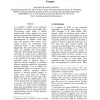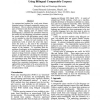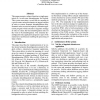104 search results - page 1 / 21 » Word Sense Disambiguation by Relative Selection |
84
Voted
IJCNLP
2005
Springer
15 years 5 months ago
2005
Springer
Abstract. This paper describes a novel method for a word sense disambiguation that utilizes relatives (i.e. synonyms, hypernyms, meronyms, etc in WordNet) of a target word and raw ...
100
click to vote
COLING
2002
14 years 12 months ago
2002
It is popular in WSD to use contextual information in training sense tagged data. Co-occurring words within a limited window-sized context support one sense among the semantically...
COLING
2002
14 years 12 months ago
2002
An unsupervised method for word sense disambiguation using a bilingual comparable corpus was developed. First, it extracts statistically significant pairs of related words from th...
108
click to vote
COLING
2000
15 years 1 months ago
2000
This paper presents a robust client/server implementation of a word sense disambiguator for English. This system associates a word with its meaning in a given context using dictio...
111
click to vote
BMCBI
2010
15 years 8 days ago
2010
Background: Word sense disambiguation (WSD) algorithms attempt to select the proper sense of ambiguous terms in text. Resources like the UMLS provide a reference thesaurus to be u...



